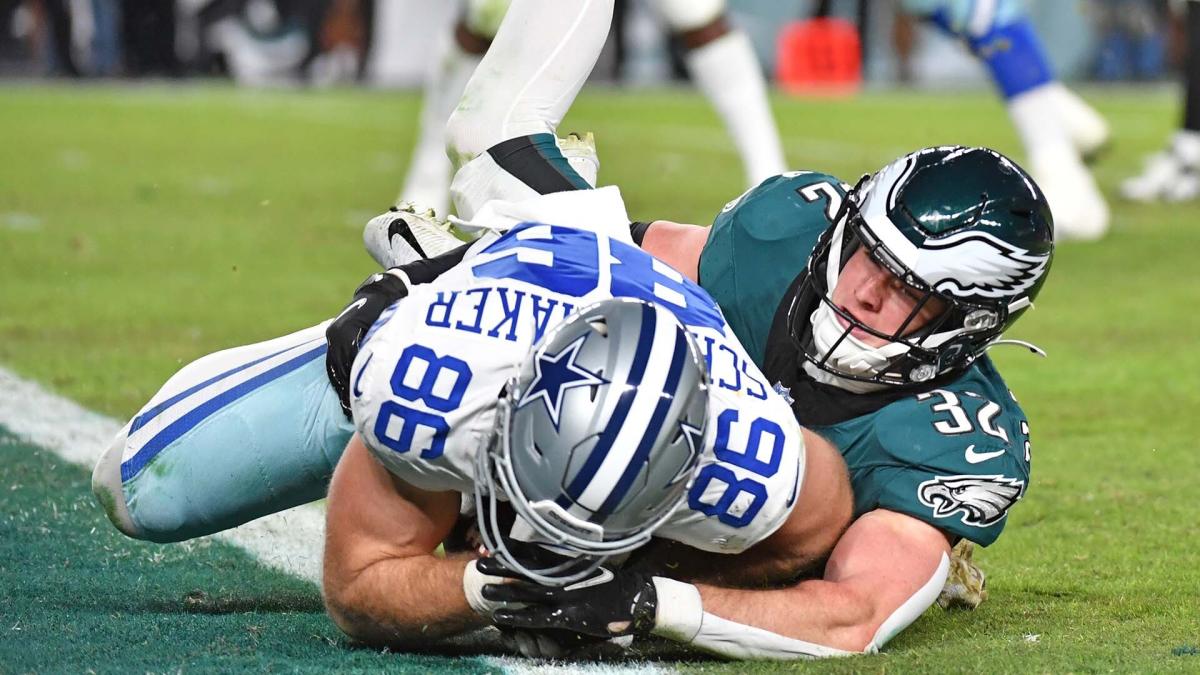After many years of trying, the NFL finally has figured out what a catch is. That doesn’t answer every question regarding the process of making a catch.
Sunday’s game between the Cowboys and Eagles included a moment that exposed a curious quirk in the rules. There’s a loophole that the rules don’t address. The league has applied an interpretation that, as best we can tell, the owners have not voted on.
It happens when a receiver is going to the ground in the field of play while making a catch. The catch isn’t complete until the player hits the ground and retains possession. The ball is spotted, however, at its location when the receiver’s knee (or other body part other than hand) strikes the ground, if he has been contacted by an opponent. From the league’s perspective, the placement of the ball when the player has landed on the ground and completed the catch does not matter.
In the Cowboys-Eagles game, it was the difference between a fourth down play ending short of the goal line and a touchdown.
During the fourth quarter, with Philadelphia leading 28-17, Dallas tight end Luke Schoonmaker caught the ball outside the end zone. When his knee struck the ground, the ball was not across the goal line. When he landed (and held onto the ball and thus completed the catch) the ball had broken the plane of the end zone.
It was not ruled a touchdown. It was ruled a turnover on downs.
“By rule he is down by contact,” the NFL explained in response to an inquiry from PFT. “The same would apply at the sideline if a receiver is in the act of completing the catch, has control and knee hits inbounds but he falls out of bounds with the ball. He is down by contact inbounds where his knee hits and the ball is dead at that point.”
At the sideline, however, the player lands out of bounds. Here, the player landed with the ball and completed the catch in the field of play. If the play isn’t over until the player “survives the ground” (as they say), why wouldn’t the ball be spotted not where it was when his knee struck, but where it was when the process of making the catch was completed?
The rulebook is silent on the issue. On one hand, Rule 7, Section 2, Article 1 provides that a play ends “when a runner is contacted by an opponent and touches the ground with any part of his body other than his hands (including the wrist) or feet (including the ankle)” and “when a forward pass (legal or illegal) is incomplete.” On the other hand, and as specified in Rule 8, Section 1, Article 4, a pass is incomplete when the process of making a catch is not completed.
So when is the process of making a catch completed? Under Rule 8, Section 1, Article 3, that happens when the three aspects of making a catch are satisfied. Step one, the player “secures control of the ball in his hands or arms prior to the ball touching the ground.” Step two, the player “touches the ground inbounds with both feet or with any part of his body other than his hands.” Step three, the player “performs any act common to the game (e.g., tuck the ball away, extend it forward, take an additional step, turn upfield, or avoid or ward off an opponent), or he maintains control of the ball long enough to do so.”
Here’s the key. If step one and two are satisfied but the player “contacts the ground and loses control of the ball, it is an incomplete pass if the ball hits the ground before he regains control, or if he regains control out of bounds.”
How, then, can the play be over when (under Rule 7, Section 2, Article 1) the runner is contacted by an opponent and touches the ground with any part of his body other than his hands if the catch has not been completed, given that (also under Rule 7, Section 2, Article 1) the play doesn’t end until a forward pass is incomplete?
It’s a very real loophole in the rules, one that the league has decided to resolve by ending the play (runner down by contact) before the play is actually over (pass is not yet incomplete).
The point is that the league has adopted an interpretation that should be resolved by the rulebook, through the normal process of proposing a specific rule and having the owners vote on it.
When is the play over? When the knee is down after a player, contacted by an opponent, is still in the act of catching a pass? Or when the catch has, or hasn’t, been made by a player who has contacted the ground without completing the third step of the catch process?
Again, this isn’t something the officiating department of the league office should be resolving on its own. It’s a clear (although rarely applied) loophole in the rules that the owners should resolve. Is the play over when a catch has been made and a knee is down? Or is the play over when the process of making a catch is, or isn’t, finished?
The answer should be in the rulebook. It’s currently not. It should be a priority for the owners to resolve this loophole in March.
Finally, there arguably isn’t a loophole at all. Rule 7, Section 2, Article 1 specifically uses the term “runner.” If the process of making the catch has not yet concluded, the receiver is not yet a runner. Which means that the play isn’t over until the catch has fully and finally been made, through maintaining possession after landing on the ground.
This makes it even more important that, sooner than later, the owners decide precisely when, in a situation like this, the play has actually ended for the purposes of spotting the ball.








